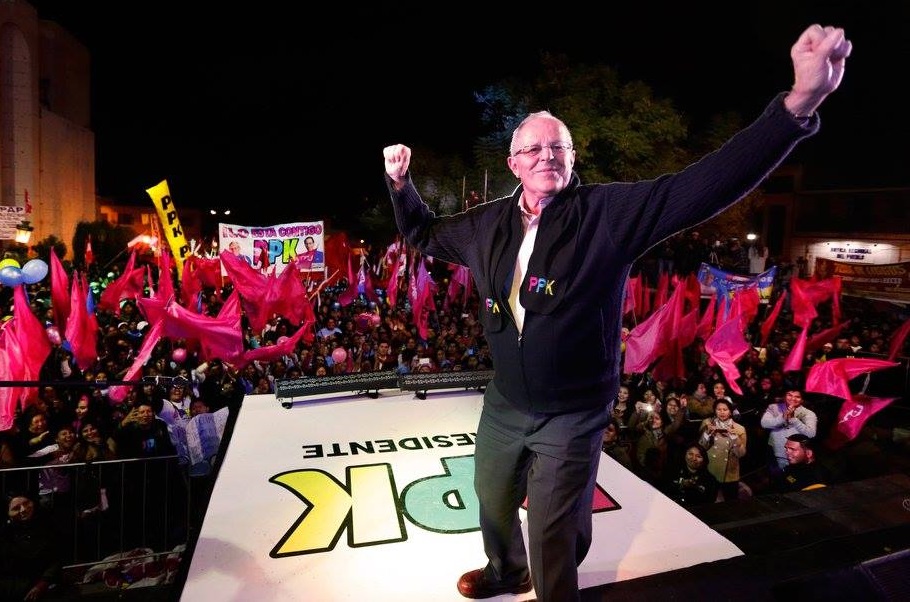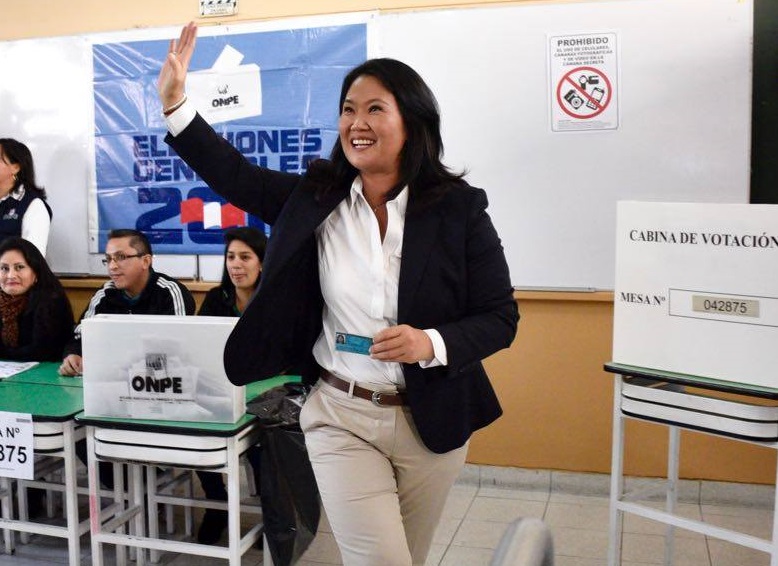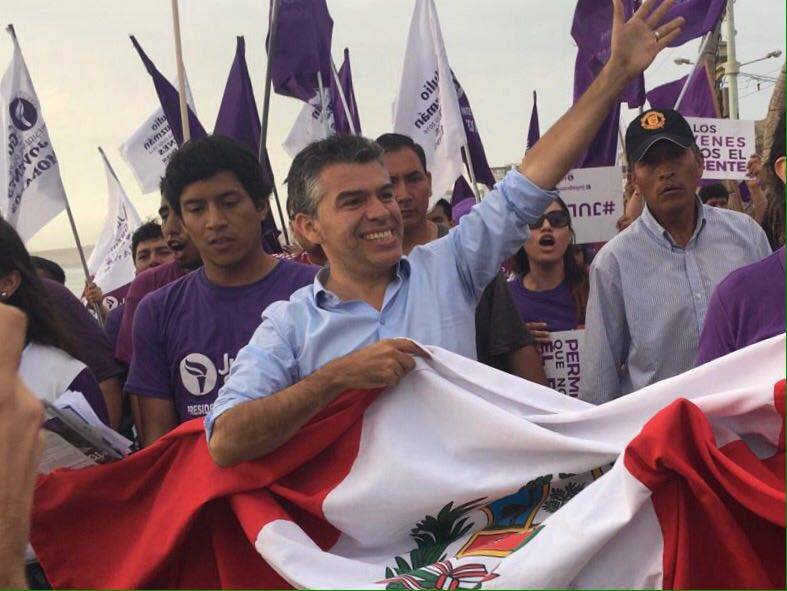
For the second time in as many elections, it’s looking like Keiko Fujimori will narrowly lose a runoff to become Peru’s president.![]()
With nearly 93% of the results counted, Fujimori was trailing behind economist Pedro Pablo Kuczynski, the 77-year-old former banker and International Monetary Fund official who served briefly as prime minister in the 2000s. Kuczynski, widely known across Peru by his initials, ‘PPK,’ was winning 50.32% of the vote to just 49.68% for Fujimori.
* * * * *
RELATED: PPK has chance to unite anti-Fujimori voters in June runoff
* * * * *
Though we do not know the exact results, and we might not know them until later today or this week, all signs point to a narrow victory for PPK, who placed third in the 2011 presidential election (behind Fujimori) and who trailed Fujimori by double digits in the initial April vote. Indeed, for years, the 2016 election seemed like it was Fujimori’s to lose. Kuczynski, an internationalist who seemed more at home in Washington, D.C. than in the Andean highlands, is not exactly a natural on the campaign trail. He took an incomprehensible break from the runoff campaign to visit New York (where he attended his daughter’s graducation, but where he also gave a speech to the Council on Foreign Relations, feeding the hype that he’s not ‘authentically’ Peruvian).
I hope that Suffragio will feature a guest post on the Peruvian election later this week. But in the meanwhile, here are some quick thoughts on what a PPK victory would mean for Peru.
1. It’s the continuity, stupid.
For a country that seemed to be riding a resources boom for the past decade or two, Peru’s economy has proved surprisingly robust and dynamic in the face of a commodities slump and increasing global volatility. It’s now the fastest growing economy in South America, and its GDP growth is hovering around 4% this year while Brazil suffers a painful economic contraction and political crisis. Part of Peru’s success story is that, since the end of Alberto Fujimori’s 1990s dictatorship, its three presidents have all been committed to the same economic policy — pro-development and pro-business, with gradual gains to reduce poverty and increase the social safety net.
That includes Alejandro Toledo, Peru’s first indigenous leader; Alan García, whose first term in office in the 1980s coincided with runaway hyperinflation; and Ollanta Humala, a former military man and leftist once thought to harbor chavista sympathies. All of them, once in office, embraced continuity over radical policy changes, especially Humala, despite the warnings of the 2011 election. PPK will be more of the same, and he’ll come to the presidency with far more international credibility than Toledo, García or Humala. He will almost certainly be more competent at managing the presidency than Humala, who went through five prime ministers in his first three years alone.
In terms of priorities, Kuczynski will almost certainly find the legislative support to raise bonds on the international markets (public debt is around just 35%) that he hopes will finance the kind of infrastructure improvements that the underdeveloped Peru drastically needs. His plan to cut taxes, especially for businesses, will prove far more difficult, given the 71-seat majority that Fujimori’s Fuerza Popular (Popular Force) holds in Peru’s 130-seat Congreso de la República (Congress) after the April congressional vote. The pro-Kuczynski faction won just 20 seats.
2. The Fujimori 2021 campaign begins tomorrow.

Though she looks to be a two-time presidential loser, Fujimori is still the most powerful politician in Peru today, and her political machine remains incredibly formidable. As noted above, her party, formed in 2011 as a vehicle to rally around Fujimori herself, controls an absolute majority in the Peruvian Congress. If she loses the presidency, it will be by the barest of margins after a campaign in which she sounded a strong (and populist) note that appeals to many Peruvians.
With politics in Peru still dominated by personalities (and not by ideological parties), Fujimori will almost certainly be the initial frontrunner for the 2021 election, at which point she will still be just 46 years old. Humala, who alienate his core leftist supporters from almost the beginning of his presidency, had no interest in consolidating the Peruvian left into a more formal movement. That may be happening under the leadership of Verónika Mendoza, whose Frente Amplio (Broad Front) holds 20 seats in Congress, and whose voters seem to have put PPK over the top after Mendoza’s endorsement. Mendoza is one of several people, including the mayor of Peru’s capital city of Lima, Luis Castañeda, who are likely to pursue 2021 candidacies. But none of them has the standing of Fujimori.
Her chief political weakness has always been the fear that she would restore her father’s political advisers to power and attempt to undermine Peruvian democracy. Given the tone of her most recent campaign, in which she promised to introduce emergency rule to combat rising crime, those fears aren’t unfounded. Nor are the fears that she would pardon her father, currently serving a 25-year sentence for human rights abuses.
By 2021, however, it will be a decade since Keiko Fujimori’s first presidential bid, and Alberto Fujimori will be 82 years old. With a firm power base in the Peruvian Congress, Keiko will have five years to demonstrate her responsibility with legislative power. She will also have five years to take advantage of Kuczynski’s relative lack of political charisma to advance her own political career and policy priorities. All of Peru’s presidents have left office with low approval ratings, and PPK (who will also be 82 years old when his term ends) could find himself an unpopular lame duck sooner rather than later. All of which gives Fujimori the political tools to dominate Peru’s agenda.
3. The election’s most important moment was in March

In many ways, the runoff seemed to matter little to Peru’s long-term trajectory. Though Fujimori took a more populist tone in 2016 than in 2011, both she and PPK were business-friendly candidates unlikely to upset a quarter-century of economic policy continuity.
Though it’s easy to forget after the bitter two-month runoff campaign, perhaps the most pivotal moment in Peru’s 2016 campaign came back in March. That’s when the national elections board disqualified Julio Guzmán, a former deputy minister in the Humala administration and a former IMF economist, from running for the presidency, all on the basis of a minor rules technicality. At the time, the 36-year-old Guzmán was rapidly climbing in the polls, and it seems likely that he would have made a tougher runoff opponent for Keiko than even PPK.
We’ll never know, of course, since Peruvians were never permitted to vote for him. The board’s decision smacked of the kind of protections designed to shield political elites from broad-based challenges to corruption and opacity. Though PPK has championed political trans
It was a disappointing setback for Peruvian democracy. It may be that Guzmán will use his 2016 disqualification to rally supporters in 2021, but it’s just as likely that the Guzmán moment will have passed by 2021. Either way, the dangerous precedent will remain as a tool to undermine democracy as an obstacle to popular outsiders in the future.